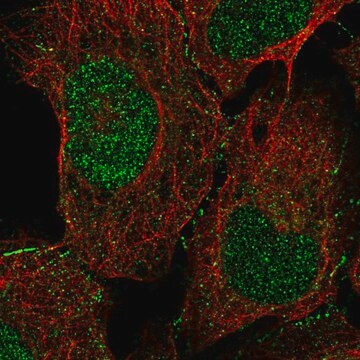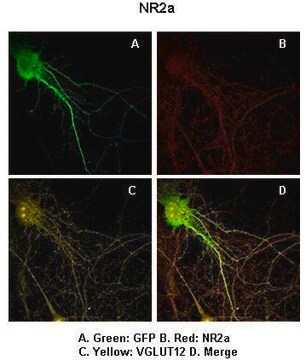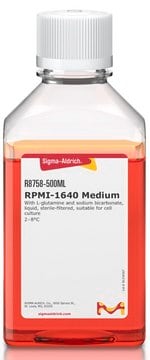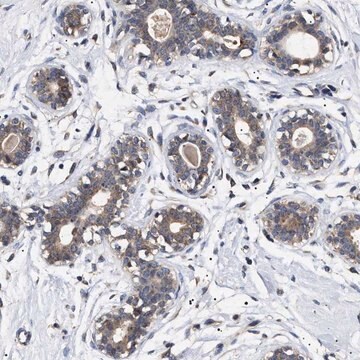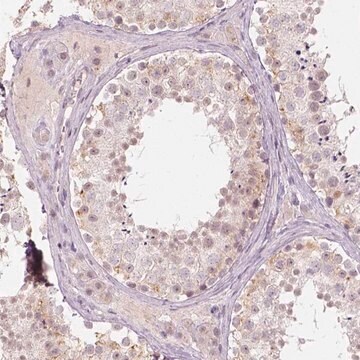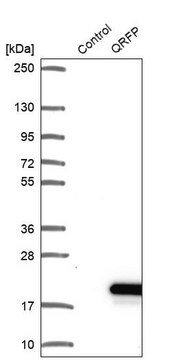HPA014300
Anti-QRFPR antibody produced in rabbit
Prestige Antibodies® Powered by Atlas Antibodies, affinity isolated antibody, buffered aqueous glycerol solution
동의어(들):
Anti-AQ27, Anti-G-protein coupled receptor 103, Anti-GPR103, Anti-Orexigenic neuropeptide QRFP receptor, Anti-Pyroglutamylated RFamide peptide receptor, Anti-SP9155
로그인조직 및 계약 가격 보기
모든 사진(2)
About This Item
추천 제품
생물학적 소스
rabbit
Quality Level
결합
unconjugated
항체 형태
affinity isolated antibody
항체 생산 유형
primary antibodies
클론
polyclonal
제품 라인
Prestige Antibodies® Powered by Atlas Antibodies
양식
buffered aqueous glycerol solution
종 반응성
human
기술
immunohistochemistry: 1:20- 1:50
면역원 서열
MQALNITPEQFSRLLRDHNLTREQFIALYRLRPLVYTPELPGRAKLA
배송 상태
wet ice
저장 온도
−20°C
타겟 번역 후 변형
unmodified
유전자 정보
human ... GPR103(84109)
일반 설명
The gene QRFPR (pyroglutamylated RFamide peptide receptor) is also referred to as GPR103. It encodes an orphan G protein-coupled receptor that is mainly expressed in the cerebral cortex, pituitary, thalamus, hypothalamus, basal forebrain, midbrain, and pons. This receptor shares homology with Orexin, neuropeptide FF, and cholecystokinin (CCK) receptors.
면역원
Pyroglutamylated RFamide peptide receptor recombinant protein epitope signature tag (PrEST)
애플리케이션
All Prestige Antibodies Powered by Atlas Antibodies are developed and validated by the Human Protein Atlas (HPA) project and as a result, are supported by the most extensive characterization in the industry.
The Human Protein Atlas project can be subdivided into three efforts: Human Tissue Atlas, Cancer Atlas, and Human Cell Atlas. The antibodies that have been generated in support of the Tissue and Cancer Atlas projects have been tested by immunohistochemistry against hundreds of normal and disease tissues and through the recent efforts of the Human Cell Atlas project, many have been characterized by immunofluorescence to map the human proteome not only at the tissue level but now at the subcellular level. These images and the collection of this vast data set can be viewed on the Human Protein Atlas (HPA) site by clicking on the Image Gallery link. We also provide Prestige Antibodies® protocols and other useful information.
The Human Protein Atlas project can be subdivided into three efforts: Human Tissue Atlas, Cancer Atlas, and Human Cell Atlas. The antibodies that have been generated in support of the Tissue and Cancer Atlas projects have been tested by immunohistochemistry against hundreds of normal and disease tissues and through the recent efforts of the Human Cell Atlas project, many have been characterized by immunofluorescence to map the human proteome not only at the tissue level but now at the subcellular level. These images and the collection of this vast data set can be viewed on the Human Protein Atlas (HPA) site by clicking on the Image Gallery link. We also provide Prestige Antibodies® protocols and other useful information.
생화학적/생리학적 작용
The G protein-coupled receptor 103 encoded by the gene QRFPR (pyroglutamylated RFamide peptide receptor) is activated by its ligand QRFP, a 43-amino acid RF-amide peptide, and this binding regulates feeding by increasing food intake, body weight, and fat mass. This complex may also be involved in the regulation of adipogenesis in an autocrine/paracrine dependent manner. QRFP is also participates in the release of aldosterone.
특징 및 장점
Prestige Antibodies® are highly characterized and extensively validated antibodies with the added benefit of all available characterization data for each target being accessible via the Human Protein Atlas portal linked just below the product name at the top of this page. The uniqueness and low cross-reactivity of the Prestige Antibodies® to other proteins are due to a thorough selection of antigen regions, affinity purification, and stringent selection. Prestige antigen controls are available for every corresponding Prestige Antibody and can be found in the linkage section.
Every Prestige Antibody is tested in the following ways:
Every Prestige Antibody is tested in the following ways:
- IHC tissue array of 44 normal human tissues and 20 of the most common cancer type tissues.
- Protein array of 364 human recombinant protein fragments.
결합
Corresponding Antigen APREST72793
물리적 형태
Solution in phosphate-buffered saline, pH 7.2, containing 40% glycerol and 0.02% sodium azide
법적 정보
Prestige Antibodies is a registered trademark of Merck KGaA, Darmstadt, Germany
면책조항
Unless otherwise stated in our catalog or other company documentation accompanying the product(s), our products are intended for research use only and are not to be used for any other purpose, which includes but is not limited to, unauthorized commercial uses, in vitro diagnostic uses, ex vivo or in vivo therapeutic uses or any type of consumption or application to humans or animals.
적합한 제품을 찾을 수 없으신가요?
당사의 제품 선택기 도구.을(를) 시도해 보세요.
Storage Class Code
10 - Combustible liquids
WGK
WGK 1
Flash Point (°F)
Not applicable
Flash Point (°C)
Not applicable
개인 보호 장비
Eyeshields, Gloves, multi-purpose combination respirator cartridge (US)
가장 최신 버전 중 하나를 선택하세요:
Ying Jiang et al.
The Journal of biological chemistry, 278(30), 27652-27657 (2003-04-26)
Orphan G-protein-coupled receptors are a large class of receptors whose cognate ligands are unknown. SP9155 (also referred to as AQ27 and GPR103) is an orphan G-protein-coupled receptor originally cloned from a human brain cDNA library. SP9155 was found to be
Shinobu Takayasu et al.
Proceedings of the National Academy of Sciences of the United States of America, 103(19), 7438-7443 (2006-05-02)
Here, we report the isolation and characterization of an endogenous peptide ligand of GPR103 from rat brains. The purified peptide was found to be the 43-residue RF-amide peptide QRFP. We also describe two mouse homologues of human GPR103, termed mouse
Mukandila Mulumba et al.
Molecular endocrinology (Baltimore, Md.), 24(8), 1615-1625 (2010-06-11)
The activation of G protein-coupled receptor 103 (GPR103) by its endogenous peptidic ligands, QRFPs, is involved in the central regulation of feeding by increasing food intake, body weight, and fat mass after intracerebroventricular injection in mice. However, the role of
Cecilia Lindskog et al.
Journal of proteomics, 75(9), 2611-2620 (2012-04-03)
Beta cell-specific surface targets are required for non-invasive monitoring of beta cell mass, which could be used for evaluation of new diabetes treatments as well as to help unravel pathogenic mechanisms underlying beta cell dysfunction. By antibody-based proteomics, we have
자사의 과학자팀은 생명 과학, 재료 과학, 화학 합성, 크로마토그래피, 분석 및 기타 많은 영역을 포함한 모든 과학 분야에 경험이 있습니다..
고객지원팀으로 연락바랍니다.
